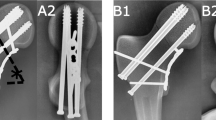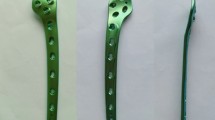Abstract
Background
The treatment of the reverse oblique osteoporotic femur fractures is still problematic and can be complicated especially that are accompanied by a fragmented lateral cortex.
Aim
The aim of this study was to compare three different internal fixation methods in the osteosynthesis of osteoporotic reverse oblique intertrochanteric femur fracture models with a fragmented lateral cortex.
Study design
Biomechanical experiment study.
Methods
A total of 24 osteoporotic femur models were obtained and divided into three groups [Group A: Proximal femoral nail (PFN), Group B: 95° angled blade plate (ABP), and Group C: proximal femoral anatomic locking plate (PFLP)] with each group which include eight bones. A standard fracture configuration was created as a reverse oblique intertrochanteric fracture and fixed with these implants. After fixation, all femur constructs were tested with an Instron 5800R tester (Instron, Canton, MA) in the biomechanics laboratory with axial loading and bending forces to assess axial and rotational stiffness and failure load. Displacement over 10 mm and angulation greater than 10° in the fracture line were considered as failure.
Results
In all tests, ABP had statistically poorer results in comparison to the PFN and PFLP group. PFLP fixation had better biomechanical fixation results in comparison to the PFN group, although the results were not statistically significant.
Conclusion
Orthopaedic surgeons should keep in mind that lateral cortex comminution brings further instability to these reverse oblique intertrochanteric osteoporotic fractures and high rates of failure may be encountered due to this instability. PFLP fixation may be an alternative fixation method biomechanically for these instable fractures.



Similar content being viewed by others
Change history
04 March 2019
This study was done with the financial support of the Istanbul University Scientific Research Projects.
References
Burge R, Dawson-Hughes B, Solomon DH, Wong JB, King A, Tosteson A. Incidence and economic burden of osteoporosis-related fractures in the United States, 2005–2025. J Bone Miner Res. 2007;22:465–75.
Radford PJ, Needoff M, Webb JK. Aprospective randomised comparison of the dynamic hip screw and the gamma locking nail. J Bone Jt Surg Br. 1993;75(5):789–93.
Nuber S, Schönweiss T, Rüter A. Stabilisation of unstable trochanteric femoral fractures. Dynamic hip screw (DHS) with trochanteric stabilisation plate vs. proximal femur nail (PFN). Unfallchirurg. 2003;106(1):39–47.
Mittal R, Banerjee S. Proximal femoral fractures: principles of management and review of literature. J Clin Orthop Trauma. 2012;3(1):15–23.
Zha GC, Chen ZL, Qi XB, Sun JY. Treatment of pertrochanteric fractures with a proximal femur locking compression plate. Injury. 2011;42(11):1294–9.
Kokoroghiannis C, Aktselis I, Deligeorgis A, Fragkomichalos E, Papadimas D, Pappadas I. Evolving concepts of stability and intramedullary fixation of intertrochanteric fractures—a review. Injury. 2012 Jun;43(6):686–93.
Lamb JN, Panteli M, Pneumaticos SG, Giannoudis PV. Epidemiology of pertrochanteric fractures: our institutional experience. Eur J Trauma Emerg Surg. 2014;40(3):225–32.
Yao C, Zhang CQ, Jin DX, Chen YF. Early results of reverse less invasive stabilization system plating in treating elderly intertrochanteric fractures: a prospective study compared to proximal femoral nail. Chin Med J (Engl). 2011;124:2150–7.
Loizou C, Mcnamara I, Ahmed K, Pryor G, Parker M. Classification of subtrochanteric femoral fractures. Injury. 2010;41:739–45.
Palm H, Jacobsen S, Sonne-Holm S, Gebuhr P. Integrity of the lateral femoral wall in intertrochanteric hip fractures: an important predictor of a reoperation. J Bone Jt Surg Am. 2007;89:470–47.
van Meeteren MC, van Rief YE, Roukema JA, et al. Condylar plate fixation of subtrochanteric femoral fractures. Injury. 1996;27:715–7.
Yoo MC, Cho YJ, Kim KI, et al. Treatment of unstable peritrochanteric femoral fractures using a 95 degrees angled blade plate. J Orthop Trauma. 2005;19:687–92.
Sadowski C, Lübbeke A, Saudan M, Riand N, Stern R, Hoffmeyer P. Treatment of reverse oblique and transverse intertrochanteric fractures with use of an intramedullary nail or a 95 degrees screw-plate: a prospective, randomized study. J Bone Jt Surg Am. 2002;84-A(3):372–81.
Kumar N, Kataria H, Yadav CS, Gadagoli BS, Raj R. Evaluation of proximal femoral locking plate in unstable extracapsular proximal femoral fractures: surgical technique and mid term follow up results. J Clin Orthop Trauma. 2014;5(3):137–45.
Kraus J, Volf V, Burget F, Jindrová B. PCCP versus standard proximal femoral nail in the treatment of pertrochanteric femoral fractures. Rozhl Chir. 2009;88(8):469–74.
Streubel PN, Moustoukas M, Obremskey WT. Locked plating versus cephalomedullary nailing of unstable intertrochanteric femur fractures. Eur J Orthop Surg Traumatol. 2016;26(4):385–90.
Johnson B, Stevenson J, Chamma R, Patel A, Rhee SJ, Lever C, Starks I, Roberts PJ. Short-term follow-up of pertrochanteric fractures treated using the proximal femoral locking plate. J Orthop Trauma. 2014;28(5):283–7.
Collinge CA, Hymes R, Archdeacon M, Streubel P, Obremskey W, Weber T, Watson JT, Lowenberg D, Members of the Proximal Femur Working Group of the Southeast Trauma Consortium. Unstable proximal femur fractures treated with proximal femoral locking plates: a retrospective, multicenter study of 111 cases. J Orthop Trauma. 2016;30(9):489–95.
Zderic I, Oh JK, Stoffel K, Sommer C, Helfen T, Camino G, Richards G, Nork SE, Gueorguiev B. Biomechanical analysis of the proximal femoral locking compression plate: do quality of reduction and screw orientation influence construct stability? J Orthop Trauma. 2018;32(2):67–74.
Ma JX, Wang J, Xu WG, Yu JT, Yang Y, Ma XL. Biomechanical outcome of proximal femoral nail antirotation is superior to proximal femoral locking compression plate for reverse oblique intertrochanteric fractures: a biomechanical study of intertrochanteric fractures. Acta Orthop Traumatol Turc. 2015;49(4):426–32.
Singh AK, Narsaria N, Gupta RK. A biomechanical study comparing proximal femur nail and proximal femur locking compression plate in fixation of reverse oblique proximal femur fractures. Injury. 2017;48(10):2050–3.
Ozkan K, Türkmen İ, Sahin A, Yildiz Y, Erturk S, Soylemez MS. A biomechanical comparison of proximal femoral nails and locking proximal anatomic femoral plates in femoral fracture fixation: a study on synthetic bones. Indian J Orthop. 2015;49(3):347–51.
Floyd MW, France JC, Hubbard DF. Early experience with the proximal femoral locking plate. Orthopedics. 2013;36(12):1488–94.
Funding
This research did not receive any specific grant from funding agencies in the public, commercial, or not-for-profit sectors.
Author information
Authors and Affiliations
Corresponding author
Ethics declarations
Conflict of interest
The authors declare that they have no conflict of interest.
Rights and permissions
About this article
Cite this article
Polat, G., Akgül, T., Ekinci, M. et al. A biomechanical comparison of three fixation techniques in osteoporotic reverse oblique intertrochanteric femur fracture with fragmented lateral cortex. Eur J Trauma Emerg Surg 45, 499–505 (2019). https://doi.org/10.1007/s00068-018-1061-1
Received:
Accepted:
Published:
Issue Date:
DOI: https://doi.org/10.1007/s00068-018-1061-1




